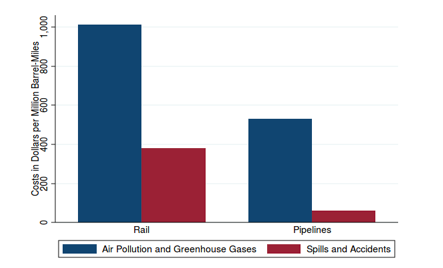Comparing the Accident and Environmental Costs of Shipping Crude Oil by Railroad versus Pipelines
Over the last decade, the transportation of domestically produced crude oil from oil fields to refineries has generated intense policy debate – mostly focused on a small number of rail and pipeline spills and accidents. Less attention has been paid to the ways in which crude oil transportation generates environmentally costly air pollution and greenhouse gases. Yet railroad locomotives burn diesel fuel, while pipelines use electricity to pump crude oil, much of it produced at coal-fired power plants. Two questions need to be posed and answered: How big are costs of spills and accidents for crude oil transport by rail versus pipelines? And how substantial are the costs of air pollution and greenhouse gasses generated by rail versus pipeline transportation of crude oil?
The Costs of Spills and Accidents, Air Pollution, and Greenhouse Gases
Costs of spills and accidents encompass cleanups and efforts to deal with harm to human health. Calculated in terms of million barrel miles, the estimated cost of spills and accidents is $62 for pipelines and $381 for rail. Rail costs are much higher because pipelines are mostly laid through thinly populated areas; and pipelines are less likely to experience a very expensive disaster in terms of lives lost or property damaged.
Air pollution costs include effects on human health, crop and timber yields, degradation of buildings and material, and reduced visibility and recreation.
- Trains emit air pollution at ground level as locomotives run along tracks. Even relatively modern locomotives emit a variety of pollutants including large quantities of pollutants that undergo chemical processes in the atmosphere and turn into fine particulate pollution, which is particularly harmful to human health. Most of the effects of this type of pollution occur within 60 miles of the rail line. Since rail lines run into and through large urban areas, they expose large numbers of people to this pollution.
- Power plants spew pollution higher into the atmosphere, affecting a larger geographic area. These pollutants also turn into fine particulates, and the harms are largest in urban areas near or downwind of the power plant.
Costs of greenhouse gas emissions are borne throughout the world. Before it was recently disbanded by President Trump, the Interagency Working Group on Social Cost of Greenhouse Gases estimated the social cost of carbon in 2013 using numbers that reflect “changes in net agricultural productivity, human health, property damages from increased flood risk, and the value of ecosystem services due to climate change.” For pipeline transport of crude oil in particular, the total air pollution and greenhouse gas cost per million barrel miles is $531, while the cost is $1,015 for rail transport. For pipelines, the air pollution cost is $273 and the carbon dioxide cost is $257, while the air pollution cost of rail transport is $814 and the carbon dioxide cost is $201. The external costs for rail are higher than pipelines for spills and air pollution but lower for greenhouse gas emissions. Air pollution is by far the largest rail cost, because air pollution increases mortality risks.
Costs for Crude Oil Transported by Railroad versus Pipelines from the Gulf Coast

Policy Implications
Rail transport of crude oil has declined since a peak in 2014 and is likely to further decline as the Dakota Access Pipeline is opened. Nevertheless, high volumes of similar products are still transported – ethanol, butane, propane, isobutane, and processed petroleum products.
If firms had to pay the full social costs of moving goods by rail and pipeline, short- and long-term changes would probably occur. In the short run, pipeline transport could increase, depending on pipeline capacity; and there might also be shifts in rail transport toward less densely populated areas. Over the longer term, investments in pipelines could grow; rail routes could be added and upgraded in less densely populated areas; and rail transport across densely populated areas might rely more on electric locomotives.
In practice, could incentives for firms shift enough to speed such changes? Although it is difficult to implement taxes that cause firms to pay the full social costs, there are alternatives:
- Diesel taxes could be increased on fuel for locomotives (and perhaps for other types of vehicles). This would affect relative costs, but might not create strong enough incentives for firms to reduce diesel locomotive use in densely populated areas.
- Another approach would be to provide low-interest loans to boost financial returns to pipelines; or the Federal Energy Regulatory Commission could increase the allowable rate of return for pipelines. If rates of return improved for investors, more pipelines would be built. In turn, firms looking to transport crude oil would probably use the expanded pipeline capacity, because this form of transport is cheaper than railroads.
